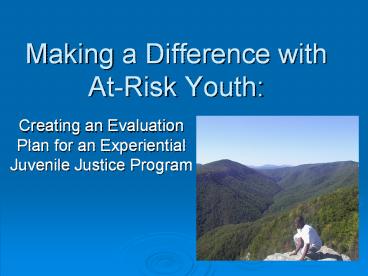Making a Difference with At-Risk Youth:
1 / 26
Title:
Making a Difference with At-Risk Youth:
Description:
Making a Difference with At-Risk Youth: Creating an Evaluation Plan for an Experiential Juvenile Justice Program Suzanna Sharkey, Ph.D. Director of Experiential ... –
Number of Views:204
Avg rating:3.0/5.0
Title: Making a Difference with At-Risk Youth:
1
Making a Difference with At-Risk Youth
- Creating an Evaluation Plan for an Experiential
Juvenile Justice Program
2
Suzanna Sharkey, Ph.D.Director of Experiential
EducationAssociated Marine Institutes
3
What is AMI?
4
History of AMI
- Associated Marine Institutes
- 1969
- One judges vision of a different way
- Florida Ocean Science Institute
- Currently have 60 programs in 8 states
- Day treatment, residential, WINGS, Infinity
5
Mission of AMI
- Associated Marine Institutes (AMI) is a
non-profit organization dedicated to helping
troubled youth develop into responsible and
productive citizens. - AMIs mission is to protect the public safety and
positively impact as many youth as possible
through the efforts of a diverse and innovative
staff.
6
Thirteen Values of AMI
- Kids First
- Integrity
- Dedication
- Safety
- Family
- Excellence
- Enthusiasm
- Goal Oriented
- Diversity
- Creativity
- Loyalty
- Leadership
- Honesty
7
AMIs Logic Model
8
Outcomes
- Lower recidivism
- Increase educational gains
- Increased favorable completion rates
- Stakeholder satisfaction
- Staff retention
9
Experiential Education at AMI
10
AMIs Definition of Experiential Education
- The presence of regularly scheduled, challenging
and exciting activities that do the following - engage our students physically, emotionally and
mentally - enrich learning
- provide staff-student bonding opportunities and
- create a unique personality for the program with
which students, staff, and the community are
proud to be associated.
11
New Model for Educating At-Risk Youth
- Tools for social and emotional development
- Tools to create safe opportunities in class for
youth to experiment with success and failure - Tools to lead students to a place where they can
take responsibility - Tools to help students care for themselves and
others
12
Experiential Education at AMI
- Traditional methods
- SCUBA Diving
- Boating/Seamanship
- White Water Rafting
- Rappelling
- Horse and Dog programs
- AMI Olympics
- Kayaking and canoeing
- ROPES courses
13
Standards-Based Experiential Education
- Character Education through Martial Arts
- SCUBA diving aligned with state standards
- Enhancing academics through EE
- Science
- Taxonomy and snorkeling
- Reading
- Mental Imagery
- Health
- Create your own restaurant
14
Research at AMI
15
Student Information System - SIS
16
What is the SIS Database?
- SIS stands for Student Information System.
- SIS is a database that records information about
kids served in AMI programs.
17
Cycle of SIS Data
18
Comparisons
- Compare UA outcomes of those youth that
participated in EE and those that did not. - Compare UA outcomes of those programs that
incorporate EE into education and those that did
not. - Compare UA outcomes of those programs that have
at least one ongoing EE component with those that
do not.
19
Data Points/Sources
- Did the youth participate in an EE activity? If
so, which one(s)? - SIS data entry
- Was he/she certified? (if applicable)
- SIS data entry
- If youth SCUBA certified, how many recreational
dives did they complete while at the program? - SIS data entry
- Is participation in EE incorporated into all
three components of the UA? - Observation
- SIS data entry
- Student/staff surveys
- Does the program incorporate EE into its
educational curriculum? - Observation
- Lesson plans
- Student/staff surveys
20
Research Questions Program based
- Did those programs who incorporated EE into
education have higher educational gains? - Did those programs who utilize EE in all three
components of the UA have lower recidivism rates?
- Did those programs who utilize EE in all three
components of the UA have higher completion
rates? - Did those programs who utilize EE in all three
components of the UA have higher staff retention
rates?
21
Research QuestionsStudent based
- Were those youth who participated in EE less
likely to re-offend? - Were those youth who participated in EE more
likely to complete the program favorably? - Do those youth who participated in EE as part of
their education have higher educational gains?
22
Research Questions Staff based
- Do programs that incorporate EE have higher staff
retention rates? - Are the teachers who utilize EE in their
curriculum more likely to be satisfied in their
jobs? - Do the teachers who utilize EE in their
curriculum report lower incidences of behavioral
issues in class?
23
Challenges
- Data accuracy
- Timeliness of entry
- Consistency
- EE Training
- Money
24
(No Transcript)
25
Questions andDiscussion
26
Contact Information
- Suzanna Sharkey
- Cell 813-395-2558
- Email sas_at_amikids.org
- Website www.amikids.org































